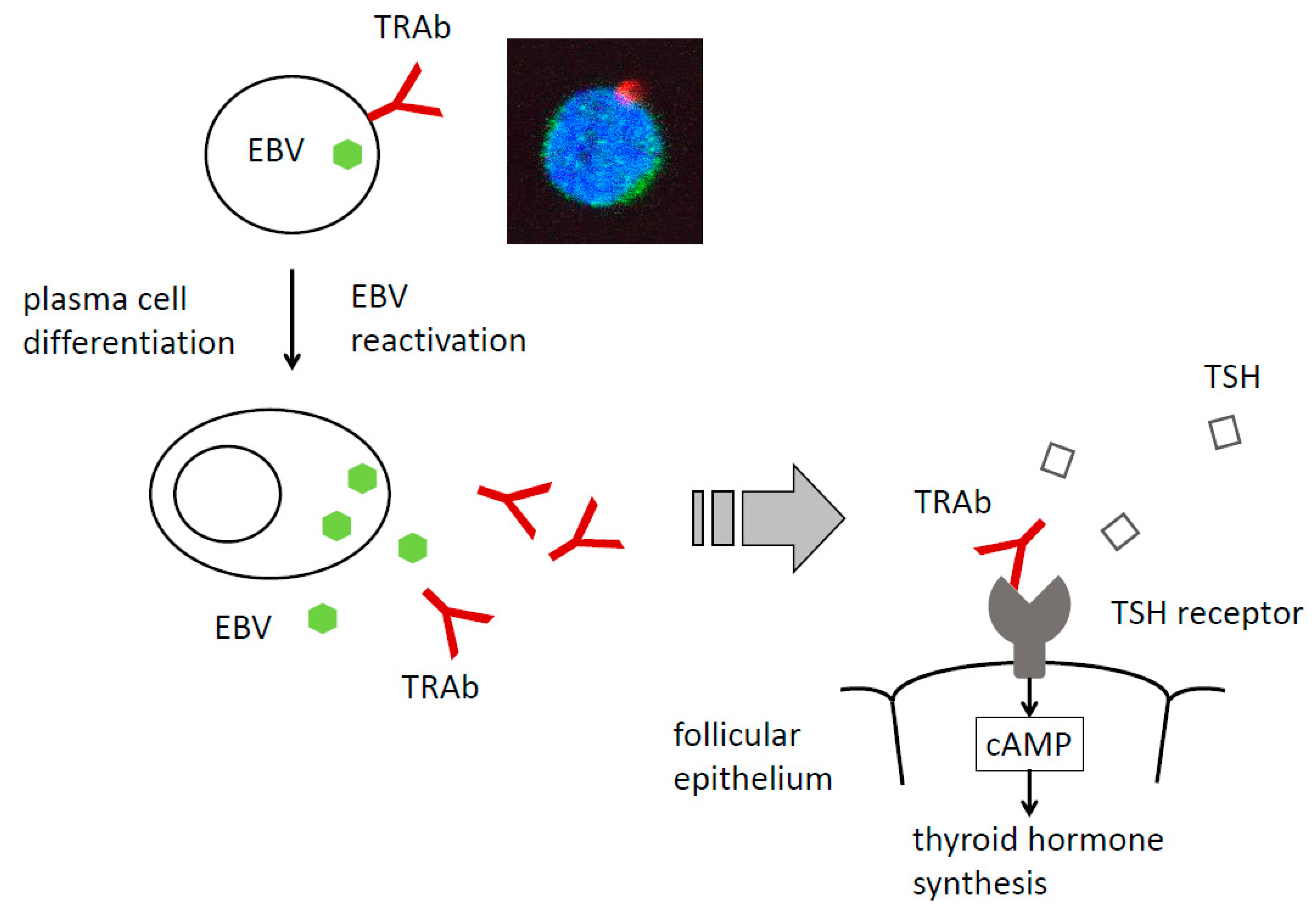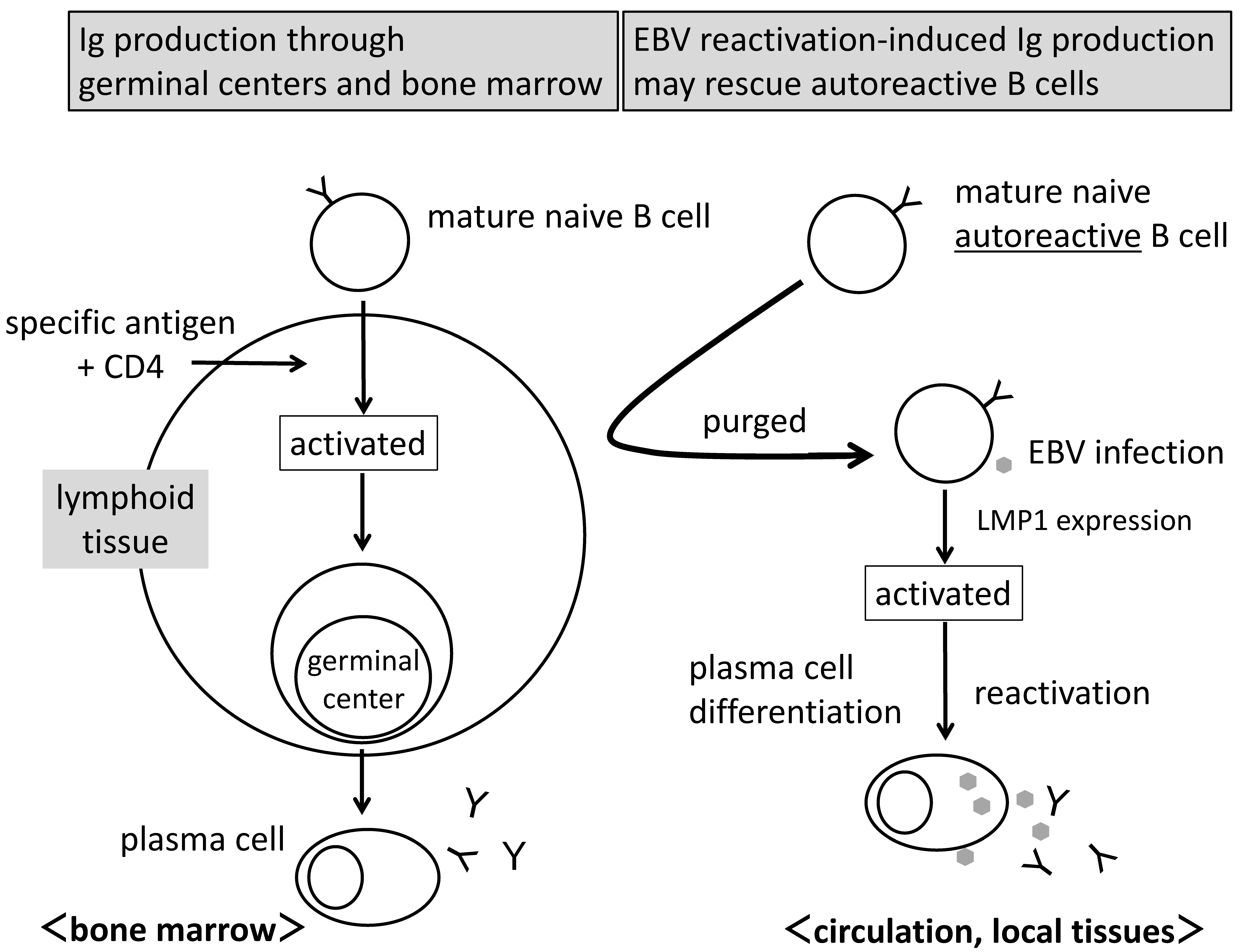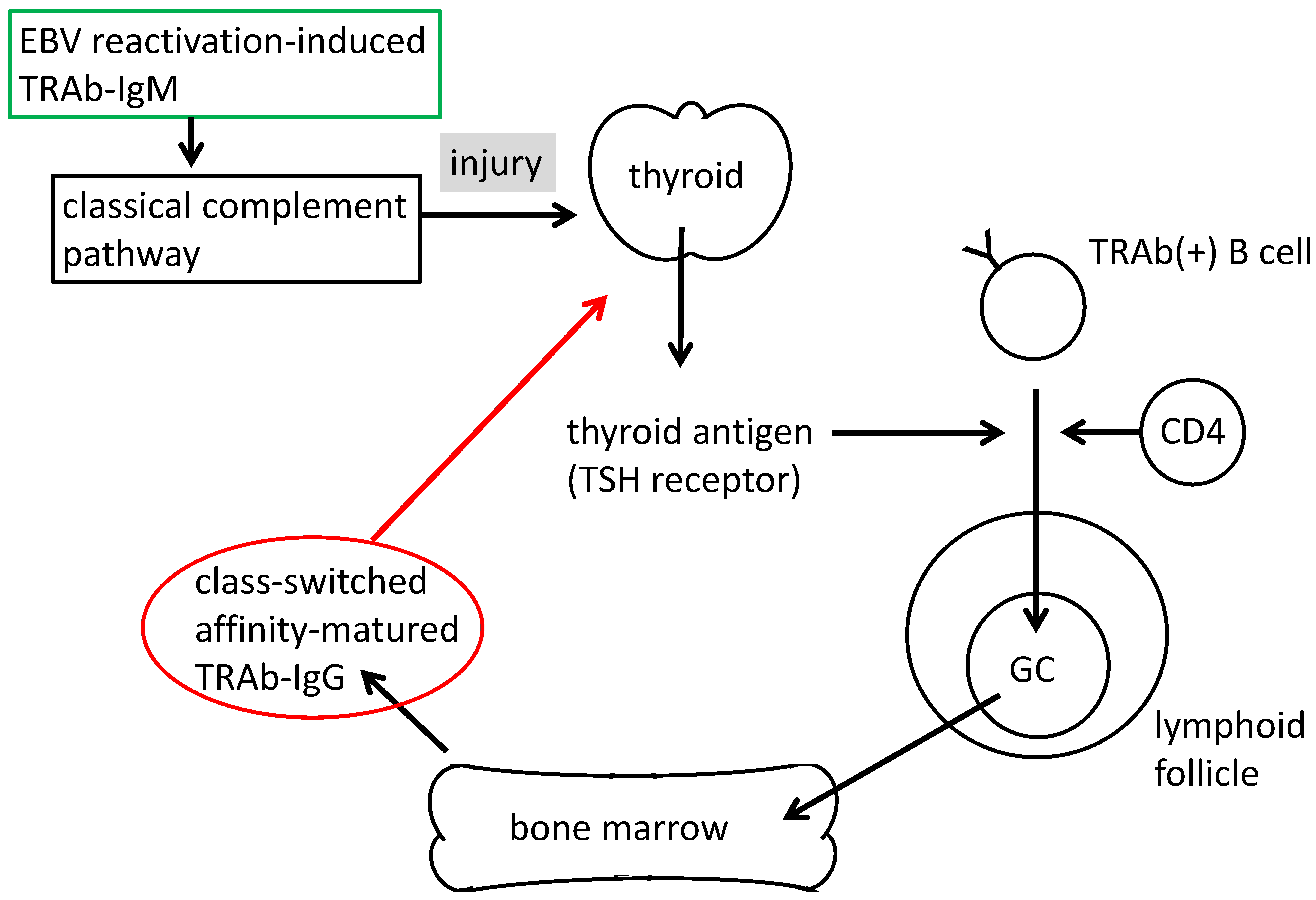Epstein–Barr Virus Reactivation-Induced Immunoglobulin Production: Significance on Autoimmunity
Abstract
1. Introduction
2. EBV and Its Reactivation
3. Graves’ Disease Is an Autoimmune Thyroid Disease
4. EBV Lytic Reactivation Stimulates Antibody Production by Host B Cells
4.1. Detection of EBV-Infected B Cells That Have Autoantibodies on Their Surface
4.2. Autoantibody Production Induced by EBV Reactivation
5. Difference between Patients and Controls
6. Mechanisms of EBV Reactivation-Induced Ig Production
6.1. EBV Reactivation Also Induces Class-Switched Antibodies
6.2. EBV Infection Causes Polyclonal B Cell Activation
6.3. EBV Reactivation-Induced Ig Production as an Alternative System
6.4. Characteristics of EBV Reactivation Induced Ig Production
6.4.1. IgM Dominance
6.4.2. Ubiquitous Ig Production
6.4.3. Rescue of Autoreactive B Cells
6.5. Role of Antibodies Induced by EBV Reactivation
7. How the EBV Reactivation-Induced Ig Production System Can Be Connected to the Development and Exacerbation of Autoimmune Diseases
8. T Cell Involvement in Autoimmunity
9. Conclusions
10. Patents
Author Contributions
Funding
Acknowledgments
Conflicts of Interest
Abbreviations
| EBV | Epstein-Barr Virus |
| TRAb | Thyrotropin Receptor Antibody |
| TSH | Thyroid Stimulating Hormone (Thyrotropin) |
| LMP1 | Latent Membrane Protein 1 |
| NF-κB | Nuclear Factor κB |
| AID | Activation-Induced Cytidine Deaminase |
| CSR | Class-Switch Recombination |
| SHM | Somatic Hypermutation |
| GC | Germinal Center |
References
- Longnecker, R.M.; Kieff, E.; Cohen, J. Epstein–Barr virus. In Fields Virology, 6th ed.; Knipe, D.M., Howley, P.M., Eds.; Lippincott Williams & Wilkins: Philadelphia, PA, USA, 2013; pp. 1898–1959. [Google Scholar]
- Münz, C.; Lünemann, J.D.; Getts, M.T.; Miller, S.D. Antiviral immune responses: Triggers of or triggered by autoimmunity? Nat. Rev. Immunol. 2009, 9, 246–258. [Google Scholar] [CrossRef] [PubMed]
- Pender, M. Preventing and curing multiple sclerosis by controlling Epstein-Barr virus infection. Autoimmun. Rev. 2009, 8, 563–568. [Google Scholar] [CrossRef] [PubMed]
- Harley, J.B.; Chen, X.; Pujato, M.; Miller, D.; Maddox, A.; Forney, C.; Magnusen, A.F.; Lynch, A.; Chetal, K.; Yukawa, M.; et al. Transcription factors operate across disease loci, with EBNA2 implicated in autoimmunity. Nat. Genet. 2018, 50, 699–707. [Google Scholar] [CrossRef]
- Lünemann, J.D.; Jelcić, I.; Roberts, S.; Lutterotti, A.; Tackenberg, B.; Martin, R.; Münz, C. EBNA1-specific T cells from patients with multiple sclerosis cross react with myelin antigens and co-produce IFN-gamma and IL-2. J. Exp. Med. 2008, 205, 1763–1773. [Google Scholar] [CrossRef] [PubMed]
- McClain, M.T.; Heinlen, L.D.; Dennis, G.J.; Roebuck, J.; Harley, J.B.; James, J.A. Early events in lupus humoral autoimmunity suggest initiation through molecular mimicry. Nat. Med. 2005, 11, 85–89. [Google Scholar] [CrossRef]
- Emery, P.; Deodhar, A.; Rigby, W.F.; Isaacs, J.D.; Combe, B.; Racewicz, A.J.; Latinis, K.; Abud-Mendoza, C.; Szczepanski, L.J.; Roschmann, R.A.; et al. Efficacy and safety of different doses and retreatment of rituximab: A randomised, placebo-controlled trial in patients who are biological naive with active rheumatoid arthritis and an inadequate response to methotrexate (Study Evaluating Rituximab’s Efficacy in MTX iNadequate rEsponders (SERENE)). Ann. Rheum. Dis. 2010, 69, 1629–1635. [Google Scholar]
- Catapano, F.; Chaudhry, A.N.; Jones, R.B.; Smith, K.G.C.; Jayne, D.W. Long-term efficacy and safety of rituximab in refractory and relapsing systemic lupus erythematosus. Nephrol. Dial. Transpl. 2010, 25, 3586–3592. [Google Scholar] [CrossRef]
- Bar-Or, A.; Pender, M.P.; Khanna, R.; Steinman, L.; Hartung, H.P.; Maniar, T.; Croze, E.; Aftab, B.T.; Giovannoni, G.; Joshi, M.A. Epstein-Barr Virus in Multiple Sclerosis: Theory and Emerging Immunotherapies. Trends Mol. Med. 2020, 26, 296–310. [Google Scholar] [CrossRef]
- McInnes, I.B.; Schett, G. The pathogenesis of rheumatoid arthritis. NEJM 2011, 365, 2205–2219. [Google Scholar] [CrossRef]
- Muñoz, L.E.; Janko, C.; Schulze, C.; Schorn, C.; Sarter, K.; Schett, G.; Herrmann, M. Autoimmunity and chronic inflammation-two clearance-related steps in the etiopathogenesis of SLE. Autoimmun. Rev. 2010, 10, 38–42. [Google Scholar] [CrossRef]
- Uchida, J.; Yasui, T.; Takaoka-Shichijo, Y.; Muraoka, M.; Kulwichit, W.; Raab-Traub, N.; Kikutani, H. Mimicry of CD40 signals by Epstein-Barr virus LMP1 in B lymphocyte responses. Science 1999, 286, 300–303. [Google Scholar] [CrossRef] [PubMed]
- Xu, Z.; Pone, E.J.; Al-Qahtani, A.; Park, S.R.; Zan, H.; Casali, P. Regulation of aicda expression and AID activity: Relevance to somatic hypermutation and class switch DNA recombination. Crit. Rev. Immunol. 2007, 27, 367–397. [Google Scholar] [CrossRef] [PubMed]
- Sutton, R.N.; Emond, R.T.; Thomas, D.B.; Doniach, D. The occurrence of autoantibodies in infectious mononucleosis. Clin. Exp. Immunol. 1974, 17, 427–436. [Google Scholar] [PubMed]
- Rhodes, G.; Rumpold, H.; Kurki, P.; Patrick, K.M.; Carson, D.A.; Vaughan, J.H. Autoantibodies in infectious mononucleosis have specificity for the glycine-alanine repeating region of the Epstein-Barr virus nuclear antigen. J. Exp. Med. 1987, 165, 1026–1040. [Google Scholar] [CrossRef] [PubMed]
- Akahori, H.; Takeshita, Y.; Saito, R.; Kaneko, S.; Takamura, T. Graves’ disease associated with infectious mononucleosis due to primary Epstein-Barr virus infection: Report of 3 cases. Intern. Med. 2010, 49, 2599–2603. [Google Scholar] [CrossRef] [PubMed]
- Nagata, K.; Okuno, K.; Ochi, M.; Kumata, K.; Sano, H.; Yoneda, N.; Ueyama, J.; Matsushita, M.; Kuwamoto, S.; Kato, M.; et al. Production of thyrotropin receptor antibodies in acute phase of infectious mononucleosis due to Epstein-Barr virus primary infection: A case report of a child. Springerplus 2015, 4, 456. [Google Scholar] [CrossRef] [PubMed]
- Rosén, A.; Gergely, P.; Jondal, M.; Klein, G.; Britton, S. Polyclonal Ig production after Epstein-Barr virus infection of human lymphocytes in vitro. Nature 1977, 267, 52–54. [Google Scholar] [CrossRef]
- Nakamura, M.; Burastero, S.E.; Ueki, Y.; Larrick, J.W.; Notkins, A.L.; Casali, P. Probing the normal and autoimmune B cell repertoire with Epstein-Barr virus. Frequency of B cells producing monoreactive high affinity autoantibodies in patients with Hashimoto’s disease and systemic lupus erythematosus. J. Immunol. 1988, 141, 4165–4172. [Google Scholar]
- Casali, P.; Nakamura, M.; Ginsberg-Fellner, F.; Notkins, A.L. Frequency of B cells committed to the production of antibodies to insulin in newly diagnosed patients with insulin-dependent diabetes mellitus and generation of high affinity human monoclonal IgG to insulin. J. Immunol. 1990, 144, 3741–3747. [Google Scholar]
- Fan, J.L.; Desai, R.K.; Dallas, J.S.; Wagle, N.M.; Seetharamaiah, G.S.; Prabhakar, B.S. High frequency of B cells capable of producing anti-thyrotropin receptor antibodies in patients with Graves’ disease. Clin. Immunol. Immunopathol. 1994, 71, 69–74. [Google Scholar] [CrossRef]
- Tamoto, N.; Nagata, K.; Hara, S.; Nakayama, Y.; Kuwamoto, S.; Matsushita, M.; Kato, M.; Hayashi, K. Subclinical Epstein-Barr Virus Primary Infection and Lytic Reactivation Induce Thyrotropin Receptor Autoantibodies. Viral Immunol. 2019, 32, 362–369. [Google Scholar] [CrossRef] [PubMed]
- Cohen, J.I. Epstein-Barr virus infection. NEJM 2000, 343, 481–492. [Google Scholar] [CrossRef] [PubMed]
- Kanda, T.; Kamiya, M.; Maruo, S.; Iwakiri, D.; Takada, K. Symmetrical localization of extrachromosomally replicating viral genomes on sister chromatids. J. Cell Sci. 2007, 120, 1529–1539. [Google Scholar] [CrossRef] [PubMed]
- Hammerschmidt, W.; Sugden, B. Genetic analysis of immortalizing functions of Epstein-Barr virus in human B lymphocytes. Nature 1989, 340, 393–397. [Google Scholar] [CrossRef]
- Johannsen, E.; Koh, E.; Mosialos, G.; Tong, X.; Kieff, E.; Grossman, S.R. Epstein-Barr virus nuclear protein 2 transactivation of the latent membrane protein 1 promoter is mediated by J kappa and PU.1. J. Virol. 1995, 69, 253–262. [Google Scholar] [CrossRef]
- Minamitani, T.; Yasui, T.; Ma, Y.; Zhou, H.; Okuzaki, D.; Tsai, C.Y.; Sakakibara, S.; Gewurz, B.E.; Kieff, E.; Kikutani, H. Evasion of affinity-based selection in germinal centers by Epstein-Barr virus LMP2A. Proc. Natl. Acad. Sci. USA 2015, 112, 11612–11617. [Google Scholar] [CrossRef]
- Kenney, S.C.; Mertz, J.E. Regulation of the latent-lytic switch in Epstein-Barr virus. Semin. Cancer Biol. 2014, 26, 60–68. [Google Scholar] [CrossRef]
- Crawford, D.H.; Ando, I. EB virus induction is associated with B-cell maturation. Immunology 1986, 59, 405–409. [Google Scholar]
- Laichalk, L.L.; Thorley-Lawson, D.A. Terminal differentiation into plasma cells initiates the replicative cycle of Epstein-Barr virus in vivo. J. Virol. 2005, 79, 1296–1307. [Google Scholar] [CrossRef]
- Grimm-Geris, J.M.; Dunmire, S.K.; Duval, L.M.; Filtz, E.A.; Leuschen, H.J.; Schmeling, D.O.; Kulasingam, S.L.; Balfour, H.H. Screening for Epstein-Barr virus (EBV) infection status in university freshmen: Acceptability of a gingival swab method. Epidemiol. Infect. 2019, 147, e140. [Google Scholar] [CrossRef]
- Mandel, S.J.; Larsen, P.R.; Davies, P. Thyrotoxicosis. In Williams Textbook of Endocrinology, 11th ed.; Melmed, S., Polonsky, K.S., Larsen, P.R., Kronenberg, H.M., Eds.; Saunders: Philadelphia, PA, USA, 2007; pp. 333–376. [Google Scholar]
- Paschke, R.; Ludgate, M. The thyrotropin receptor in thyroid diseases. N. Engl. J. Med. 1997, 337, 1675–1681. [Google Scholar] [CrossRef] [PubMed]
- Morshed, S.A.; Latif, R.; Davies, T.F. Characterization of thyrotropin receptor antibody-induced signaling cascades. Endocrinology 2009, 150, 519–529. [Google Scholar] [CrossRef] [PubMed]
- Rees Smith, B.; Hall, R. Thyroid-stimulating immunoglobulins in Graves’ disease. Lancet 1974, 2, 427–431. [Google Scholar] [CrossRef]
- Morshed, S.A.; Davies, T.F. Graves’ Disease Mechanisms: The Role of Stimulating, Blocking, and Cleavage Region TSH Receptor Antibodies. Horm. Metab. Res. 2015, 47, 727–734. [Google Scholar] [CrossRef] [PubMed]
- Weetman, A.P.; Yateman, M.E.; Ealey, P.A.; Black, C.M.; Reimer, C.B.; Williams, R.C., Jr.; Shine, B.; Marshall, N.J. Thyroid-stimulating antibody activity between different immunoglobulin G subclasses. J. Clin. Investig. 1990, 86, 723–727. [Google Scholar] [CrossRef] [PubMed]
- Kraiem, Z.; Cho, B.Y.; Sadeh, O.; Shong, M.H.; Pickerill, P.; Weetman, A.P. The IgG subclass distribution of TSH receptor blocking antibodies in primary hypothyroidism. Clin. Endocrinol. 1992, 37, 135–140. [Google Scholar] [CrossRef] [PubMed]
- Furmaniak, J.; Sanders, J.; Rees Smith, B. Blocking type TSH receptor antibodies. Auto Immun. Highlights 2012, 21, 11–26. [Google Scholar] [CrossRef]
- Weetman, A.P.; McGregor, A.M.M. Autoimmune thyroid disease: Further developments in our understanding. Endocr. Rev. 1994, 15, 788–830. [Google Scholar]
- Tomer, Y.; Huber, A. The etiology of autoimmune thyroid disease: A story of genes and environment. J. Autoimmun. 2009, 32, 231–239. [Google Scholar] [CrossRef]
- Brix, T.H.; Christensen, K.; Holm, N.V.; Harvald, B.; Hegedüs, L. A population-based study of Graves’ disease in Danish twins. Clin. Endocrinol. 1998, 48, 397–400. [Google Scholar] [CrossRef]
- Nagata, K.; Fukata, S.; Kanai, K.; Segawa, T.; Satoh, Y.; Hayashi, K.; Sairenji, T. The influence of Epstein-Barr virus reactivation in patients with Graves’ disease. Viral Immunol. 2011, 24, 143–149. [Google Scholar] [CrossRef] [PubMed]
- Weiss, L.M.; Movahed, L.A. In situ demonstration of Epstein-Barr viral genomes in viral-associated B cell lymphoproliferations. Am. J. Pathol. 1989, 134, 651–659. [Google Scholar] [PubMed]
- Greifenegger, N.; Jäger, M.; Kunz-Schughart, L.A.; Wolf, H.; Schwarzmann, F. Epstein-Barr virus small RNA (EBER) genes: Differential regulation during lytic viral replication. J. Virol. 1998, 72, 9323–9328. [Google Scholar] [CrossRef] [PubMed]
- Kimura, H.; Miyake, K.; Yamauchi, Y.; Nishiyama, K.; Iwata, S.; Iwatsuki, K.; Gotoh, K.; Kojima, S.; Ito, Y.; Nishiyama, Y. Identification of Epstein-Barr virus (EBV)-infected lymphocyte subtypes by flow cytometric in situ hybridization in EBV-associated lymphoproliferative disease. J. Infect. Dis. 2009, 200, 1073–1087. [Google Scholar] [CrossRef] [PubMed]
- Nagata, K.; Higaki, K.; Nakayama, Y.; Miyauchi, H.; Kiritani, Y.; Kanai, K.; Matsushita, M.; Iwasaki, T.; Sugihara, H.; Kuwamoto, S.; et al. Presence of Epstein-Barr virus-infected B lymphocytes with thyrotropin receptor antibodies on their surface in Graves’ disease patients and in healthy individuals. Autoimmunity 2014, 47, 193–200. [Google Scholar] [CrossRef]
- Hinuma, Y.; Konn, M.; Yamaguchi, J.; Wudarski, D.J.; Blakeslee, J.R., Jr.; Grace, J.T., Jr. Immunofluorescence and herpes-type virus particles in the P3HR-1 Burkitt lymphoma cell line. J. Virol. 1967, 1, 1045–1051. [Google Scholar] [CrossRef]
- Sairenji, T.; Hinuma, Y. Re-evaluation of a transforming strain of Epstein-Barr virus from the Burkitt lymphoma cell line, Jijoye. Int. J. Cancer 1980, 26, 337–342. [Google Scholar] [CrossRef]
- Sairenji, T.; Bertoni, G.; Medveczky, M.M.; Medveczky, P.G.; Nguyen, Q.V.; Humphreys, R.E. Inhibition of Epstein-Barr virus (EBV) release from P3HR-1 and B95-8 cell lines by monoclonal antibodies to EBV membrane antigen gp350/220. J. Virol. 1988, 62, 2614–2621. [Google Scholar] [CrossRef]
- Nagata, K.; Nakayama, Y.; Higaki, K.; Ochi, M.; Kanai, K.; Matsushita, M.; Kuwamoto, S.; Kato, M.; Murakami, I.; Iwasaki, T.; et al. Reactivation of persistent Epstein-Barr virus (EBV) causes secretion of thyrotropin receptor antibodies (TRAbs) in EBV-infected B lymphocytes with TRAbs on their surface. Autoimmunity 2015, 48, 328–335. [Google Scholar] [CrossRef]
- Thorley-Lawson, D.A.; Gross, A. Persistence of the Epstein-Barr virus and the origins of associated lymphomas. N. Engl. J. Med. 2004, 350, 1328–1337. [Google Scholar] [CrossRef]
- Telenti, A.; Uehlinger, D.E.; Marchesi, F.; Germann, D.; Malinverni, R.; Matter, L. Epstein-Barr virus infection in HIV-positive patients. Eur. J. Clin. Microbiol. Infect. Dis. 1993, 12, 601–609. [Google Scholar] [CrossRef] [PubMed]
- Kawaguchi, A.; Kanai, K.; Satoh, Y.; Touge, C.; Nagata, K.; Sairenji, T.; Inoue, Y. The evolution of Epstein-Barr virus inferred from the conservation and mutation of the virus glycoprotein gp350/220 gene. Virus Genes 2009, 38, 215–223. [Google Scholar] [CrossRef] [PubMed]
- Cohen, J.I.; Wang, W.; Mannick, J.; Kieff, E. Epstein-Barr virus nuclear protein 2 is a key determinant of lymphocyte transformation. Proc. Natl. Acad. Sci. USA 1989, 86, 9558–9562. [Google Scholar] [CrossRef] [PubMed]
- Lin, Z.; Wang, X.; Strong, M.J.; Concha, M.; Baddoo, M.; Xu, G.; Baribault, C.; Fewell, C.; Hulme, W.; Hedges, D.; et al. Whole-genome sequencing of the Akata and Mutu Epstein-Barr virus strains. J. Virol. 2013, 87, 1172–1182. [Google Scholar] [CrossRef]
- Needham, J.; Adamson, A.L. BZLF1 transcript variants in Epstein-Barr virus-positive epithelial cell lines. Virus Genes 2019, 55, 779–785. [Google Scholar] [CrossRef]
- Nagata, K.; Kumata, K.; Nakayama, Y.; Satoh, Y.; Sugihara, H.; Hara, S.; Matsushita, M.; Kuwamoto, S.; Kato, M.; Murakami, I.; et al. Epstein-Barr virus lytic reactivation activates B cells polyclonally and induces activation-induced cytidine deaminase expression: A mechanism underlying autoimmunity and its contribution to Graves’ disease. Viral Immunol. 2017, 30, 240–249. [Google Scholar] [CrossRef]
- Muramatsu, M.; Kinoshita, K.; Fagarasan, S.; Yamada, S.; Shinkai, Y.; Honjo, T. Class switch recombination and hypermutation require activation-induced cytidine deaminase (AID), a potential RNA editing enzyme. Cell 2000, 102, 553–563. [Google Scholar] [CrossRef]
- Heath, E.; Begue-Pastor, N.; Chaganti, S.; Croom-Carter, D.; Shannon-Lowe, C.; Kube, D.; Feederle, R.; Delecluse, H.J.; Rickinson, A.B.; Bell, A.I. Epstein-Barr virus infection of naive B cells in vitro frequently selects clones with mutated immunoglobulin genotypes: Implications for virus biology. PLoS Pathog. 2012, 8, e1002697. [Google Scholar] [CrossRef]
- Klein, U.; Küppers, R.; Rajewsky, K. Evidence for a large compartment of IgM-expressing memory B cells in humans. Blood 1997, 89, 1288–1298. [Google Scholar] [CrossRef]
- He, B.; Raab-Traub, N.; Casali, P.; Cerutti, A. EBV-encoded latent membrane protein 1 cooperates with BAFF/BLyS and APRIL to induce T cell-independent Ig heavy chain class switching. J. Immunol. 2003, 171, 5215–5224. [Google Scholar] [CrossRef]
- Parham, P. The development of B lymphocytes. In The Immune System, 3rd ed.; Patham, P., Ed.; Garland Science: New York, NY, USA, 2009; pp. 159–186. [Google Scholar]
- Manz, R.A.; Thiel, A.; Radbruch, A. Lifetime of plasma cells in the bone marrow. Nature 1997, 388, 133–134. [Google Scholar] [CrossRef]
- Kumata, K.; Nagata, K.; Matsushita, M.; Kuwamoto, S.; Kato, M.; Murakami, I.; Fukata, S.; Hayashi, K. Thyrotropin Receptor Antibody (TRAb)-IgM Levels Are Markedly Higher Than TRAb-IgG Levels in Graves’ Disease Patients and Controls, and TRAb-IgM Production Is Related to Epstein-Barr Virus Reactivation. Viral Immunol. 2016, 29, 459–463. [Google Scholar] [CrossRef] [PubMed]
- Nagata, K.; Hara, S.; Nakayama, Y.; Higaki, K.; Sugihara, H.; Kuwamoto, S.; Matsushita, M.; Kato, M.; Tanio, S.; Ishiguro, K.; et al. Epstein-Barr Virus Lytic Reactivation Induces IgG4 Production by Host B Lymphocytes in Graves’ Disease Patients and Controls: A Subset of Graves’ Disease Is an IgG4-Related Disease-Like Condition. Viral Immunol. 2018, 31, 540–547. [Google Scholar] [CrossRef] [PubMed]
- Crotty, S. T Follicular Helper Cell Biology: A Decade of Discovery and Diseases. Immunity 2019, 50, 1132–1148. [Google Scholar] [CrossRef] [PubMed]
- Sakaguchi, S.; Sakaguchi, N.; Asano, M.; Itoh, M.; Toda, M. Immunologic self-tolerance maintained by activated T cells expressing IL-2 receptor alpha-chains (CD25). Breakdown of a single mechanism of self-tolerance causes various autoimmune diseases. J. Immunol. 1995, 155, 1151–1164. [Google Scholar]
- Wing, J.B.; Tanaka, A.; Sakaguchi, S. Human FOXP3+ Regulatory T Cell Heterogeneity and Function in Autoimmunity and Cancer. Immunity 2019, 50, 302–316. [Google Scholar] [CrossRef]
- Wing, K.; Onishi, Y.; Prieto-Martin, P.; Yamaguchi, T.; Miyara, M.; Fehervari, Z.; Nomura, T.; Sakaguchi, S. CTLA-4 control over Foxp3+ regulatory T cell function. Science 2008, 322, 271–275. [Google Scholar] [CrossRef]




| Latent Cycle | ||
| EBNA1 | ||
| EBNA2 | ||
| EBNA3A | ||
| EBNA3B | ||
| EBNA3C | ||
| EBNA-LP | ||
| LMP1 | ||
| LMP2A | ||
| LMP2B | ||
| Lytic Cycle | ||
| BZLF1 | Immediate-early | |
| BRLF1 | replication | |
| BMRF1 | EA | |
| BALF5 | Early replication | |
| BGLF4 | ||
| BHRF1 | ||
| BCRF1 | ||
| BNRF1 | Late replication | |
| BFRF3 | VCAp18 | |
| BLRF2 | VCAp23 | |
| BDLF3 | gp150 | |
| BLLF1 | gp350/220 |
Publisher’s Note: MDPI stays neutral with regard to jurisdictional claims in published maps and institutional affiliations. |
© 2020 by the authors. Licensee MDPI, Basel, Switzerland. This article is an open access article distributed under the terms and conditions of the Creative Commons Attribution (CC BY) license (http://creativecommons.org/licenses/by/4.0/).
Share and Cite
Nagata, K.; Hayashi, K. Epstein–Barr Virus Reactivation-Induced Immunoglobulin Production: Significance on Autoimmunity. Microorganisms 2020, 8, 1875. https://doi.org/10.3390/microorganisms8121875
Nagata K, Hayashi K. Epstein–Barr Virus Reactivation-Induced Immunoglobulin Production: Significance on Autoimmunity. Microorganisms. 2020; 8(12):1875. https://doi.org/10.3390/microorganisms8121875
Chicago/Turabian StyleNagata, Keiko, and Kazuhiko Hayashi. 2020. "Epstein–Barr Virus Reactivation-Induced Immunoglobulin Production: Significance on Autoimmunity" Microorganisms 8, no. 12: 1875. https://doi.org/10.3390/microorganisms8121875
APA StyleNagata, K., & Hayashi, K. (2020). Epstein–Barr Virus Reactivation-Induced Immunoglobulin Production: Significance on Autoimmunity. Microorganisms, 8(12), 1875. https://doi.org/10.3390/microorganisms8121875





